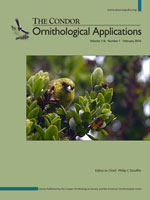Hourly or daily counts of animals during migration are used to assess change in population status. However, due to financial and logistical constraints, it is sometimes not possible to sample the entire migration, resulting in an unknown impact on accuracy and precision of estimated trends. Using simulated migration counts of 3 raptor species, commonly detected Sharp-shinned Hawks (Accipiter striatus), rarely detected Merlins (Falco columbarius), and super-flocking Broad-winged Hawks (Buteo platypterus), we used a hierarchical modeling framework to test whether sampling effort influenced accuracy and precision of trends. We subsampled simulated datasets in various ways: weekends only; a random sample of 40%, 60%, or 80% of the migration; or the first 25%, 50%, or 75% of the migration. Bias in trend estimates and probability of error (estimating a false but significant trend) varied little with sampling effort for the common and rare species, which suggests that for these species, sampling only a small subset of the migration will not increase the probability of drawing false inference from the data. However, when counts of the super-flocking species were highly variable among days, trends were strongly positively biased when the first 25% of the migration was sampled, and probability of error increased with sampling effort. For all species, probability of detecting a significant and accurate trend also improved with sampling effort, but only exceeded 80% for common and rare species when a majority of the migration was sampled. Increasing sampling effort is recommended to improve power of trend analyses for common and rare species, but for super-flocking species, randomly sampling a subset of observation days throughout the migration can minimize error, but at the expense of a ~22–25% reduction in power using 20-year datasets. For species with this pattern, other methods to improve power, such as combining data across sites, should be considered.
How to translate text using browser tools
9 December 2015
Effect of sampling effort on bias and precision of trends in migration counts
Tara L. Crewe,
Denis Lepage,
Philip D. Taylor
ACCESS THE FULL ARTICLE

The Condor
Vol. 118 • No. 1
February 2016
Vol. 118 • No. 1
February 2016
accuracy
citizen science
generalized linear mixed models
migration monitoring
power
precision
sampling design




